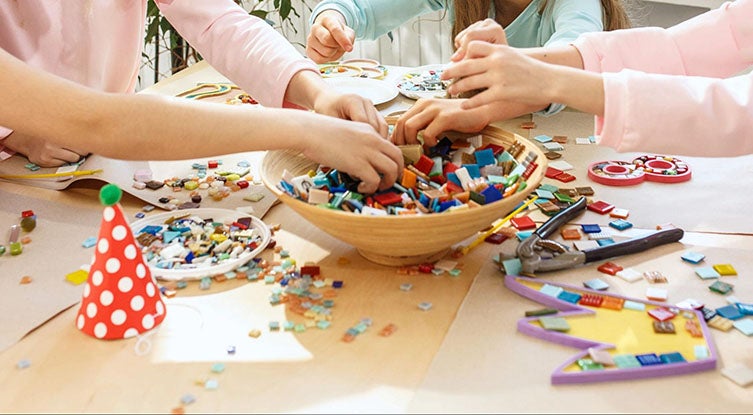Sleep is essential for physical and mental health, and especially for two- and three-year-olds. If your toddler is struggling with temper tantrums at bedtime, it’s tough on both of you.
If you and your child aren’t sleeping well, you may end up having less energy to work through the tantrums, and then you get stuck in a cycle.
We’ve got your back.
To help you navigate why tantrums happen, how to prevent them, and how to manage them when they’re happening—we’ve put together thirteen keys to keep in mind to help you and your child.
The Short Cut
- Going to sleep and staying asleep can be difficult for toddlers
- Learning why your child is having bedtime temper tantrums can help you stop them
- Bedtime rituals and a sleep-conducive environment can help your child feel calm when it’s time to rest
- Staying calm during a child’s tantrum can help them manage it
- An age- and stage-matched learning membership can help your toddler develop emotional regulation skills that will help with tantrums
6 Reasons Toddlers Have Bedtime Tantrums
Sometimes a toddler’s bedtime resistance can seem nonsensical. They seem happy, you’re following the routine—and then suddenly they’re screaming. But there are always reasons for bedtime tantrums.
If you can find out why your child is so upset at bedtime, you might be able to stop a tantrum from escalating, or avoid it in the first place. If you’re managing toddler sleep struggles, start by considering these common triggers.
1. Illness

If your child begins to have sleep struggles out of the blue, you might want to check to see if they’re sick. They might have a fever or an ear infection, which could be causing them to experience discomfort or pain.
If you can remedy their discomfort, you may be able to calm their tantrum. If you can’t, you may have to wait it out. The good news? Once your child feels well again, these tantrums should stop.
2. Sensory Issues
Some kids are especially sensitive to sensory inputs. Your child’s pajamas might feel itchy or their room might be too cold or the noise from the street too loud. These kinds of sensory intrusions can cause bedtime resistance.
Ask your child questions. Do they know why they feel bad? If they do know what the problem is, you can probably solve it (change pajamas, add a blanket, close the window, etc.).
3. Separation Anxiety
Sometimes toddlers experience some fear of being separated from their parents or caregivers, and it can become more pronounced at bedtime.
If this is true for your child, reassure them that you’re not leaving them, you’re just leaving the room. You can also try these adjustments to the bedtime routine:
- Check in on them after you leave
- Stay close by so they can hear you
- Give them a shirt of yours to sleep with
You can also lay with them for a bit, but try to leave before they fall asleep if you want them to work toward sleeping independently.
4. Fear of the Dark
Another common source of sleep struggles is fear of the dark. A night light might help with this, or you could try leaving your child’s door open and a hall light on.
5. Growing Independence
Your toddler may be exploring their freedom now. At night, this may look like asserting that they’re not tired and don’t want to go to bed (and don’t have to!).
If your child is stubbornly declaring their independence, try giving them some choices during your bedtime ritual, like what pajamas they wear or what book you read. Avoid open decision-making (“What pajamas do you want to wear?”) and focus on a choice between two things (“Do you want to wear your train pajamas or the dog ones?”)
If your toddler is having a hard time transitioning from a fun activity to bedtime, give them plenty of warning about when their last activity of the night needs to end and the bedtime ritual has to begin.
6. Too Much Energy
Sometimes your child might simply not be tired.
If this is the case, try some activities that will quiet their body. Doing some yoga exercises can help—even just a few down dogs or breathing exercises can help a child relax. Taking a bath or shower before bed is another good idea to try. Warm water might calm your child’s body down.
4 Bedtime Changes to Help with Tantrums
Whether you’ve figured out why your child is struggling before bed or not, helping your child prepare for sleep consistently can reduce bedtime temper tantrums. If you can create a ritual with them, your child may begin to settle into a routine that is calm and predictable.
You can support and strengthen their bedtime ritual by thoughtfully designing it to help them wind down. Try the following tips.
1. Create a Comfortable, Comforting Sleep Environment
Typically the best sleep environment is cool and dark, but your child has their own unique preferences. The more you can identify them the easier bedtime will be.
Soothing scents, like lavender, might help with sleep. You could try soothing music. An app or sound machine can be effective. So can blackout curtains (particularly if there’s a streetlight outside their window), a favorite blanket or comforter, and the right pajamas (or lack thereof).
2. Skip Tech Before Bedtime
While mindful screen time isn’t a problem for your child during the day, it can interfere with their relaxation process at bedtime.
The blue light emitted by screens can wreak havoc with a kid’s natural clock (and yours, for that matter!). Turning off screens at least an hour before bed gives their brain a better chance to naturally release melatonin.
Since this hormone controls your child’s sleep-wake cycle, it can help them start slowing down on their own, meaning they’ll be more ready for bed when it’s time.
3. Engage in Daytime Activity

Engaging in physical activity during the day can help regulate your child’s internal internal clock, so they intuitively know when it’s time to be awake and full of energy and when it’s time to settle for the night.
Try to make sure toddlers get a few hours a day of energetic play (running, jumping, rolling around, dancing, kicking, throwing a ball, etc.). Keeping play to a regular routine (active play before dinner and quiet play or reading after, for example) can also help kids know when it’s time to run around and when it’s time to settle down.
4. Consistent Bedtime Routine
Find a few calming activities that are enjoyable for both you and your child to signal bedtime and sleep.
You don’t have to be strict about the exact time frame or order of tasks (and you can even skip one sometimes). But the predictability of a routine helps your child’s body automatically begin to wind down.
You and your child can come up with a routine that is ideally suited to you. Many families include some or all of these steps:
- Brushing teeth
- Taking a bath
- Picking out clothes for the next day (saving time in the morning is a plus!)
- Reading books together
- Quiet chat
- Bedtime lullaby
- Snuggling
3 Ways to Work Through Toddler Bedtime Tantrums

Sometimes bedtime tantrums will happen, no matter how good your preparation is. Tantrums are normal. Some kids experience them a lot, while others only have them rarely. Either way they’re not a sign of an underlying behavioral issue.
Wondering what to do (and what not to do) during a toddler tantrum? Try the following:
1. Practice Calm
It is not easy (at all!) to remain calm when your child is screaming or rolling on the floor or kicking (especially if they’re kicking you)—but it’s a skill you can cultivate.
There are two energies in the room when you’re trying to put your child to bed—yours and your child’s—and they feed off of each other. Even if you need to intervene in the tantrum to keep your child safe, try to keep your voice and body language calm. When you do, you’re giving your child some help in regulating their feelings.
2. Name Their Feelings
Try to break the tantrum trajectory by affirming that you understand your child is upset. This validation may be all they need to calm down. If not, it can be a great first step to figuring out what they’re feeling and why.
3. Let the Tantrum Resolve Naturally
Much easier said than done! But no tantrum lasts forever. When you can, it’s a good idea to let your child’s tantrum run its course.
First and foremost, it’s important to make sure your child is safe. Once they are, try using validating and reassuring language (“I see you’re really upset right now, and that’s OK.”) without trying to stop the tantrum yourself. This can give them the gentle message that their tantrum isn’t going to get them what they want—and give their mind and body a chance to work through their emotions on their own.
At some point your child’s anger and frustration will give way and they’ll reach out to you with a different emotion. Sometimes they’ll be calm, sometimes they’ll be in tears, and sometimes they’ll be looking for quiet comfort. So stay available and be ready for that moment to come.
Managing Temper Tantrums with Begin

Even if you give your child plenty of transition time, adhere to a regular bedtime ritual, and make their room sleep-friendly, they’ll still have tantrums from time to time. And while that’s not a fun way for you to end the day, it’s okay.
Sometimes big feelings can’t be avoided. And sometimes it’s good to express them. But if you try to troubleshoot and work with your child to establish a bedtime routine that they can adhere to most of the time—you’re acing it!
We at Begin can help you.
The first stage of our learning membership, created together with the experts at Sesame Workshop, helps lay the foundation for bedtime success by providing support for toddlers and their parents as kids learn to identify and manage their feelings. Through hands-on and digital activities, special techniques you can take on the go, classes and more—all with favorite Sesame Street friends—your child can gain a better grasp of their emotions, making bedtime tantrums a whole lot easier for everyone.
Take our quiz to find out how a membership can help your family today!













